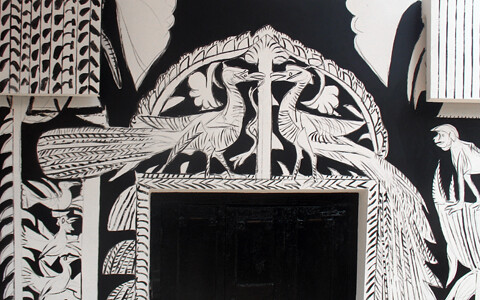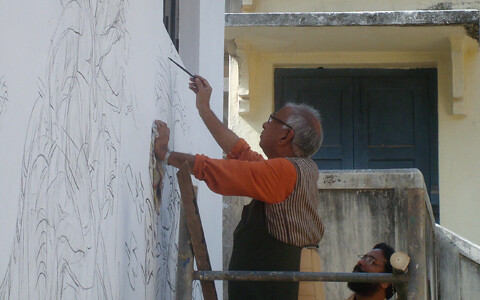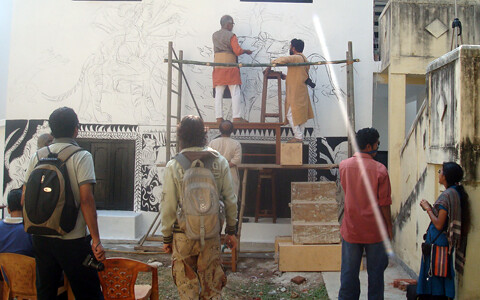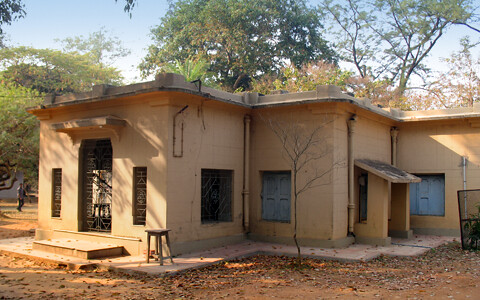
If reports are true, artist KG Subramanian is working on a new mural within the premises of Kala Bhavan campus in Santiniketan. He has already done two murals before, one over the other, on the same walls. KG Subramanian’s murals in Kala Bhavan are, in spirit, a very successful balance struck between the playfulness achieved in his drawings and sketches and the measured, if a little cadastral, spatial arrangement of his paintings. They simmer with the narrative energy of old fables with the scope of epics. Working with traditional motifs, he turns the lens of narrative traditions back on itself with clever and conscious interventions.

Detail from mural by KG Subramanian
His interventions, often involving witty reworking of traditional motifs which have gained some kind of iconic condensation of forms over the years, show how he sees himself in respect to traditions he has chosen as his fictive wells of past and allows himself to draw from: he will never portray two peacocks perching on an arch facing each other (a typical ornamental trope in traditional decorative arts, often functioning as a symmetrical frame-formation device) – he will make sure one of them is a peahen, a female, to animate such iconic formations with some purpose, breaking the symmetry of decoration and making space more painterly, as well as giving it a life by turning a decorative motif into a potent narrative-propelling image, recharging old forms with a renewed sexual and narrative energy. His existing mural in Kala Bhavan is full of such beautiful moments.

The Peacock & the Peahen; detail from mural, Kala Bhavan. 2010
Yet, on another level, KG Subramanian’s murals function as rhetoric, where the five Aristotelian canons are held paramount – invention, arrangement, style, memory & delivery (often overlapping) – and performance is crucial: the final standing work is, as it were, merely a record of the performance.

KG Subramanian working on his mural, Kala Bhavan. 2010
He is willing to erase his murals and re-perform. His ‘performances’ have been avidly followed, and vividly documented in photographs and films and often presented in sequential manner showing progress in stages.

KG Subramanian working on his mural, Kala Bhavan. 2010
This time however, he has chosen a different mode. Tiling is not only a more permanent medium, it is more premeditated, with tiles arriving in numbered sequences worked out in the studio. And given the conditions, he is also not likely to do the masonry himself.
But what surprised me was not the shift in mode or scope, but his choice of the site of the work: the building commonly referred to as artist Nandalal Bose’s studio (the first office-building built in Kala Bhavan, and currently serving as the office for the Art History Department). The architecture is attributed to Suren Kar, and it is a perfect example of the so-called Santiniketan style of architecture developed by the likes of Suren Kar, Rathindranath Tagore & Nandalal Bose through years of unattributed or collective meditations.

Nandalal Bose’s studio, Kala Bhavan.
It is also, sadly, probably the only structure in Kala Bhavan which can be described as sort of a masterpiece in itself: it cannot be extended or done over without ruining the very logic of the structure, if one has any regard for the logic therein, that is. Its symmetry and isometric contours draw a perfect closure to itself, forbidding extensions. Its sound height-to-width ratio lends itself a delicate weight – a weight and a feel that can be easily destroyed by any material tampering. It is colored, in the austere tradition of Santiniketan, a pale, almost etiolated yellow – somewhere between a fleeting flavescent and an old wan mustard. There is almost a Haiku-like austerity about the whole affair, and that is what makes it so quintessentially a product of a certain brand of imagination we have come to associate with Santiniketan and its early builders. What it really needs is, not colored tiles, but some care, some sound renovation that will restore the structure back to what it was by doing away with the careless unconcealed wiring and patchy details that have been added later rather thoughtlessly.

Nandalal Bose’s studio, Kala Bhavan.
Even without the history it bears, it’s a beautiful building. It may not be as flashy or decorative as Subramanian imagines it, but austerity can be a virtue sometimes. The mere thought of it going under the mason’s spatula with colored tiles to be slapped on it stirs a little sob in the nerves of your average history-watcher in me. And it’s a gesture which, I wouldn’t call mindless, but mighty difficult to arrive at an understanding of the purpose of from a strictly Cartesian point of view. But it has me conflicted as well. Maybe I am wrong.

Nandalal Bose’s studio, Kala Bhavan.
When a graffiti artist is hunted down charged with vandalism for smearing a wall, we know where our sympathy lies. But there’s also something touching about the desperate inscriptions on Stick-No-Bill walls, on the concrete pages of public lavatories…and on the walls of heritage sites too, monuments proclaiming the might of the high of yore. These inscriptions, marks, are also history, something tells me, a history written in form of interjections, with lipsticks and the desperation of pocket knives. This is also history: a record of people’s desires, but people who count for nothing.
In this light, maybe Subramanian should be allowed to project his desires on these austere and history-loaded walls without interruptions or unqualified dissensions like this one you are reading. And in the fashion of KG Subramanian himself, his writings, the argument can be reduced to the question of the idea of tradition & human nature itself, and no less. But then, if that is the case, my confused morals inform me, these walls should be open to others too with similar (maybe less qualified) desires. Should heritage sites be opened for public inscriptions? Whose walls are these? This is a difficult question I suddenly find myself secretly divided upon. I am in no hurry to chance upon an answer, or a solution, frankly, and not that I think I am capable of producing one. And not that it would matter, anyhow. Let the answer be born through layers of action…and remorse.
![]()
© Rarh Design Studio 2011
proiti / 04 Mar 2011